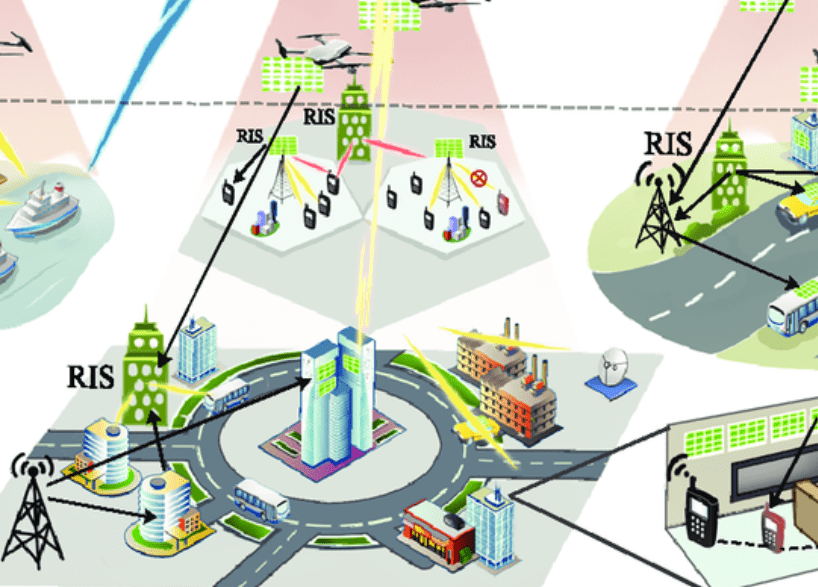RIS as network elements in 6G Networks
Reconfigurable Intelligent Surfaces (RIS) are the artificial planar meta-materials, envisioned to be used in 6G networks as network elements jointly with conventional transceivers and base stations. It is estimated that the RIS hardware market alone will be around $10bn yearly by 2030. RIS, excluding the Radiofrequency (RF) power amplifications, will be conceptually used as conventional relaying technologies like massive multiple input multiple output (mMIMO) and Backscatter Communication (BackCom).
Due to numerous benefits over the conventional relay mechanisms, the usage of RIS technology is bound to be benefitable to achieve the 6G vision and KPIs. Unlike traditional approaches, RIS passively reflects the signal with low power requirements by inducing intelligent phase-shifts, without the need for an additional Radio Frequency (RF) source. Architecturally, RIS is lightweight, thin, and easy to mount/coat and will be available at much lower costs compared to the mMIMO relaying.
In general, a passive RIS comprises a large number of passive elements; with each element made up of a reflective patch terminated with a circuit for phase shifting. However, they impose the physical limitations imposed by the multiplicative fading effect and hence the concept of active RIS. Active RISs can also reflect the incident signals with reconfigurable phase shifts. Different from passive RISs that just reflect the incident signals without amplification, active RISs can further amplify the reflected signals.
RIS will be programmable via a RIS controller using electromagnetic properties and will integrate with the xRAN components of the 5G network. The proposed architecture deploys an orchestration module responsible for the joint optimization of the available hardware resources in conjunction with the context and localization server, and the network entities that host the Multi-Access Edge Computing (MEC) and edge Artificial Intelligence (AI) functionalities.
A new network domain is envisioned between the RAN elements and the final UEs, wherein the elements of the RISs can be automatically commanded by the RISE controller within short timescales (e.g., milliseconds). This controller will be required to be interfaced with the orchestration layer via a new reference point (Rx). It will instruct transmitter configurations on long timescales (e.g., minutes) for specific environments or given use cases. In parallel, the RISE controller can adjust the RIS parameters based on the received feedback as well as the desired KPIs. Additionally, a new interface (R2) can be designed to create a direct link between the near-Real-Time (near-RT) RAN Intelligent Controller (RIC) and the RISE Controller. This will allow simultaneous control of the configurations of RIS and the beamforming of BSs in very short timescales. Finally, an “Open Environment” interface is envisaged to be developed between the RIS elements and the radio units handling the digital front, to bring flexibility and programmability.
At present, most of the research works on RIS-assisted networks focus on various terrestrial scenarios. On the other side, the demand for high throughput geostationary (GEO) satellite communications (SatCom) is rapidly growing to deliver broadband services in inaccessible/insufficient covered areas of terrestrial networks. Some researchers have also integrated RIS in SatCom networks research, where a satellite transmits the signal to a ground mobile terminal using multicarrier communications. To enhance the effective gain, the signal delivery from the satellite to the ground mobile terminal will also be assisted by RIS which will smartly shift the phase of the signal towards the ground terminal. It is considered that RIS will be mounted on a high building and equipped with multiple re-configurable passive elements along with a smart controller.
To conclude, RIS is the future of phase shift relaying technology in wireless radio networks and will be a key network element in the 6G networks of the future.

